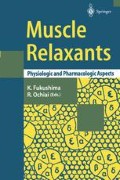Abstract
The major action of non-depolarizing neuromuscular blocking agents is that they are competitive antagonists at the skeletal muscle postjunctional nicotinic receptor. In addition, they also block acetylcholine receptors in the autonomic nervous system, including muscarinic receptors at the sino-atrial node, and nicotinic receptors at ganglia. As well as blocking the muscle postjunctional nicotinic receptors, large concentrations can produce non-competitive block by occluding the endplate channel itself. The well-known phenomena of tetanic fade and train-of-four fade have been ascribed to a prejunctional action of the compounds. This is controversial. It has been argued that the prime prejunctional effect of, for example, tubocurarine, is to reduce transmitter mobilization. Others have argued that the prime effect is to increase release. This paper describes how different elements of our research effort over the years have led to a hypothesis that attempts to unify some of these apparently contradictory views.
Access this chapter
Tax calculation will be finalised at checkout
Purchases are for personal use only
Preview
Unable to display preview. Download preview PDF.
References
Dale HH, Feldberg W, Vogt M. Release of acetylcholine at voluntary motor nerve endings. Journal of Physiology 1936; 86: 353–380.
Lingle CJ, Steinbach JH. Neuromuscular blocking. agents. International Anesthesiology Clinics 1988; 26: 288–301.
Glavinovic MI. Presynaptic action of curare. Journal of Physiology 1979; 290: 499–506.
Magleby KL, Pallotta BS, Terrar DA. The effect of (+)-tubocurarine on neuromuscular transmission during repetitive stimulation in the rat, mouse, and frog. Journal of Physiology 1981; 312: 97–113.
Gibb AJ, Marshall IG. Pre- and post-junctional effects of tubocurarine and other nicotinic antagonists during repetitive stimulation in the rat. Journal of Physiology 1984; 351: 275–297.
Bowman WC. Prejunctional and postjunctional cholinoceptors at the neuromuscular junction. Anaesthesia and Analgesia 1980; 59: 935–943.
Wilson DF. Influence of presynaptic receptors on neuromuscular transmission in rat. American Journal of Physiology 1982; 242: C366–372.
Hughes R, Chapple DJ. Effects of non-depolarizing neuromuscular blocking agents on peripheral autonomic mechanisms in cats. British Journal of Anaesthesia 1976; 48: 59–67.
Hughes R, Chapple DJ. The pharmacology of atracurium: a new competitive neuromuscular blocking agent. British Journal of Anaesthesia 1981; 53: 31–44.
Durant NN, Marshall IG, Savage DS, Nelson DJ, Sleigh T, Carlyle IC. The neuromuscular and autonomic blocking activities of pancuronium, Org NC45, and other pancuronium analogues, in the cat. Journal of Pharmacy and Pharmacology 1979; 31: 831–836.
Brittan RT, Levy GP, Tyers MB. The neuromuscular blocking action of 2-(4-phenylpiperidino) cyclohexanol (AH5183). European Journal of Pharmacology 1969; 8: 93–99.
Marshall IG. A comparison between the blocking actions of 2-(4-phenylpiperidino) cyclohexanol (AH5183) and its n-methyl quaternary analogue (AH5954). British Journal of Pharmacology 1970; 40: 68–77.
Marshall IG. Studies on the blocking action of 2-(4-phenylpiperidino) cyclohexanol (AH5183). British Journal of Pharmacology 1970; 38: 503–516.
Parsons SM, Koenigsberger R. Specific stimulated uptake of acetylcholine by Torpedo organ synaptic vesicles. Proceedings of the National Academy of Science USA 1980; 77: 6234–6238.
Marshall IG, Parsons SM. The vesicular acetylcholine transport system. Trends in Neuroscience 1987; 10: 174–177.
Parsons SM, Prior C, Marshall IG. Acetylcholine transport, storage, and release. International Review of Neurobiology 1993; 35: 279–390.
Searl T, Prior C, Marshall IG. The effects of L-vesamicol, an inhibitor of vesicular acetylcholine uptake, on two populations of miniature end-plate currents at the snake neuromuscular junction. Neuroscience 1990; 35: 145–156.
Searl T, Prior C, Marshall IG. Acetylcholine recycling and release at rat motor nerve terminals studied using (-)-vesamicol and troxypyrrolium. Journal of Physiology 1991; 444: 99–116.
Pemberton KE, Prior C, Marshall IG. The effects of vesamicol on trains of endplate currents and on focally recorded nerve terminal currents at mammalian neuromuscular junctions. British Journal of Pharmacology 1992; 105: 112–118.
Tian L, Prior C, Marshall IG. Nicotinic antagonist-produced frequencydependent changes in acetylcholine release from rat motor nerve terminals. Journal of Physiology 1994; 476: 517–529.
Katz B, Miledi R. Transmitter leakage from motor nerve endings. Proceedings of the Royal Society (London) 1977; 196: 59–72.
Author information
Authors and Affiliations
Editor information
Editors and Affiliations
Rights and permissions
Copyright information
© 1995 Springer Japan
About this paper
Cite this paper
Marshall, I.G., Prior, C., Dempster, J., Tian, L. (1995). Prejunctional Actions of Neuromuscular Blocking Drugs. In: Fukushima, K., Ochiai, R. (eds) Muscle Relaxants. Springer, Tokyo. https://doi.org/10.1007/978-4-431-66896-1_8
Download citation
DOI: https://doi.org/10.1007/978-4-431-66896-1_8
Publisher Name: Springer, Tokyo
Print ISBN: 978-4-431-66898-5
Online ISBN: 978-4-431-66896-1
eBook Packages: Springer Book Archive

